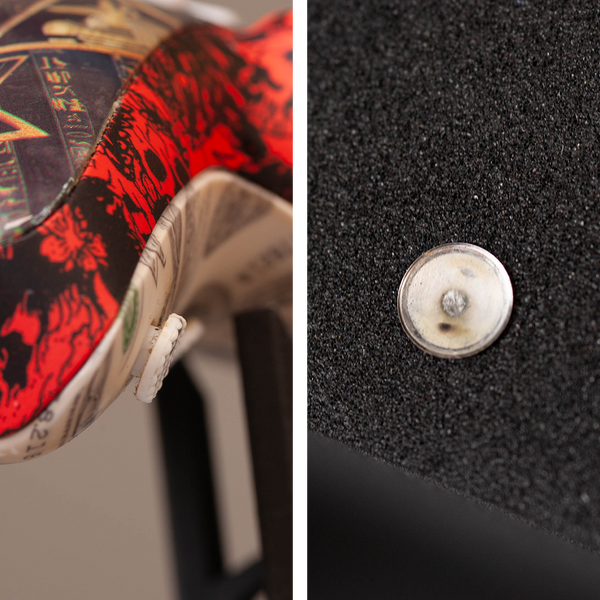TL;DR: We'll be using new IP Rated switches for our additional inputs because they will last longer than the old ones. Since we're using a new switch we have a proprietary new button cap, but the overall feel is similar to our old Rear Buttons (which you can still select in our controller designers).
How to get Beaver Buttons?
All Quick Picks with rear buttons will now come with Beaver Buttons.
Beaver Buttons are now the default option in the rear button section across all Controller Designers.
Existing orders that were open prior to 11/26/25 without production beginning have or will be emailed to upgrade to the new buttons free of charge.
New Rear Buttons for Thee
As we continue to refine and improve upon all of our performance modifications, it's always possible for us to revisit and implement any other Quality of Life improvements in the future.
One such improvement — Magneto Mechs — launched earlier this year. By retrofitting TMR sensors to the original thumbstick mechanisms of 1st Party controllers, our Magneto Mechs all but eliminate Thumbstick Drift and can stay more accurate even after thousands of hours of gaming versus other sensors.
Identifying failure points and reevaluating what components we use and how we can change them reignited our passion to make a similar durability improvement to our rear buttons. After many years of research and testing, we finally found a switch that can reliably increase the lifespan of our rear buttons without sacrificing what makes them unique.
We call them Beaver Buttons.
Way back in the before times of 2016 many of our customers, us included, weren't satisfied with our rear button longevity. To address this, we found a similar feeling switch to our one with a 100,000-click lifespan and cranked it to a much higher 1,000,000-click lifespan switch.
Frustratingly, the results weren't great. The "better" switches failed much faster in many of our customers' hands. We reverted the change and have been using the original 100k click switch type ever since. While we've continued to search for a better option since then, this research eventually took a back seat to the other improvements and modifications we've released over the years. Unfortunately, this means the issues we had with those switches have persisted even now.
Before diving into why we think the new Beaver Buttons are so great, let's explain a bit more about the current switch we use.
Tact Switches And You
The specific variety of switches we use for rear buttons, Tact Switches, are made with a metal dome that when compressed (clicked), momentarily complete the circuit and sends your input.
For our purposes, we now focus on two different characteristics of these switches when considering them for our modifications. Previously, whenever we tried finding a new switch we were focusing solely on the click-lifespan.
After our initial findings in 2016 and the data that we've collected since then, we started to investigate what we believe to be the more important characteristic, IP Rating.
What we've found is that the most common failure point of switches was not due to wear or collapsed dome pieces, but debris and oxidation inside the switch housing.
-
Click Life
After enough use over time, the little metal dome inside will collapse and no longer function. The estimated number of clicks a switch can endure before this mechanical failure is the click-lifespan. We originally believed this number would be a major determinator in our rear button's longevity.
-
IP Rating
The higher IP Rating, the more resistance there is to sweat, grime, and dust. Gamers produce plenty of each (some more than others). While keeping in mind switches with improved physical durability, we are now focusing more on resistance to the factors introduced by the human body.

In most tact switches, the metal domes aren't very well-guarded, and instead rely on their nature as internal components to protect them.
Thankfully there usually isn't enough exposure to the elements to penetrate the switch housing and cause a failure, and a higher-quality metal is also more resistant to oxidation. But over the years as manufacturers looked to cut costs they ended up using cheaper materials, so we suspect the switches we used may be more susceptible to moisture and oxidation today than they were ten years ago.
For sweaty gamers particularly, this poses a significant issue. After internal investigations of switch failure in our controllers, we were surprised to find that nearly all of them were failing due to the presence of debris and oxidation. For some customers, this would take weeks. For others, it could take years.
Introducing: Beaver Buttons
So after all these years, we're introducing the new Beaver Buttons to confront the worst that gamers have to offer!
The new switches materials are silicone-sealed, with a whopping IP Rating of 67! (*insert hand motions*) They're dust-proof, moisture-proof, and chip-proof, so even the sweatiest among us would be hard-pressed to oxidize these switches in a short amount of time.
Now that Beaver Buttons have silicone moving parts, compared to the old switches having plastic moving parts, they have a drastically different click-feel:
The Short Version: silicone is more flexible. Beaver Buttons feel click-ier, and they should be easier to spam.
The Long Version: Silicone is compressible, so the buttons have a short ramp-up period before the force directly applies to the dome. The silicone absorbs the press up to the point where it overcomes the gram force requirement for activating the switch. It then accelerates the accumulated force into the dome in an instant. This is an exponential transfer of energy. In contrast, the old switches had a linear transfer of energy. Ultimately the amount of force required to activate each switch is the same, but the primary difference is the way that force is applied. This difference means that Beaver Buttons feel click-ier, and according to our professional play testers, are easier to spam.
Availablility & Potential Variants
While we will have both Beaver Buttons and our old (Legacy) Rear Buttons available on our Controller Builders, we will only be using the new Beaver Buttons on all Quick Picks and future Pre-Built / Refurbished controllers.
For our Service Center, the new Beaver Buttons will be gradually incorporated as we make an effort to upgrade controllers that come in.
Dependent on demand, we plan on creating easier and harder to press variants of these new IP rated switches, but for the time being we will have both Beaver Buttons and Legacy Rear Buttons available.
Small teaser for the real ones that read all this:
Beaver Buttons will open the door to new Button placement locations! More info on our Index of placements coming soon!
We're excited for you to get your hands on these new rear buttons! They're now available for DualShock 4, DualSense, and Xbox Series X controller orders.
Follow us on our socials and sign up for email notifications so you don't miss out on what's to come.
Frequently Asked Questions
What if I like the old Rear Button switches?
What if I like the old Rear Button switches?
While the Beaver Button switches are better from an objective standpoint, we understand that some of you are attached to the way our rear buttons have felt for many years. For those of you who feel that way, we will continue to offer our Legacy switches as an option on the builders, which is the only way to continue ordering Legacy switches. All Quick Picks with rear buttons will have Beaver Button switches.
Additionally, please note that Beaver Buttons’ gram force input (200g) is the same as Legacy (Standard) switches. There is currently no Beaver Buttons equivalent to Legacy - Soft switches.






